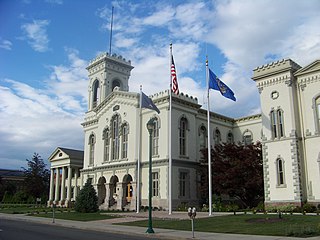
Chemung County is a county in the Southern Tier of the U.S. state of New York. The population was 84,148 as of the 2020 census. Its county seat is Elmira. Its name is derived from a Delaware Indian village whose name meant "big horn".

Tioga County is a county in the U.S. state of New York. As of the 2020 census, the population was 48,455. Its county seat is Owego. Tioga County is part of the Binghamton metropolitan area.

Ashland is a town in Chemung County, New York, United States. The population was 1,515 at the 2020 census. The town is named after the home of Henry Clay.
Chemung is a town in Chemung County, New York, United States. The population was 2,368 at the 2020 census. The town name is derived from the Chemung River, which means "Big Horn" in the native language.

Elmira Heights is a village in Chemung County, New York, United States. The population was 4,097 at the 2010 census. The village is primarily within the town of Horseheads, but part of the village is in the town of Elmira. The village is a northern suburb of the city of Elmira. It is part of the Elmira, New York Metropolitan Statistical Area.
Horseheads North is a census-designated place (CDP) in Chemung County, New York, United States. It is part of the Elmira Metropolitan Statistical Area. As of the 2010 census, the population of the CDP was 2,843.
Millport is a village in Chemung County, New York, United States. The population was 312 at the 2010 census. The name comes from its former status as a canal port.
Veteran is a town in Chemung County, New York, United States. The population was 3,363 at the 2020 census. The name of the town honors the first settler, a veteran of two wars.
Catharine is a town in Schuyler County, New York, United States. The population was 1,656 at the 2020 census. The town is one of two in the county named after Catherine Montour, a Native American interpreter and leader in the area. The Town of Catharine is in the southeastern part of the county and is north of Elmira.
Montour is a town in Schuyler County, New York, United States. The population was 2,323 at the 2020 census. The town is one of two towns in the county named after Catherine Montour.
Barton is a town in southwestern Tioga County, New York, United States. The population was 8,570 at the 2020 census. It is southeast of Elmira.
Tioga is a town in Tioga County, New York, United States. The population was 4,455 at the 2020 census. The town is in the southwestern part of the county and lies between Elmira and Binghamton. Tioga is situated in the Southern Tier District of New York.

Waverly is the largest village in Tioga County, New York, United States. As of the 2010 U.S. census, Waverly had a population of 4,177. It is located southeast of Elmira in the Southern Tier region. This village was incorporated as the southwest part of the town of Barton in 1854. The village name was conceived by Joseph "Uncle Joe" Hallett, founder of its first Fire Department and pillar of the community, dropping the second "e" from the name of his favorite author's novel, Waverley by Sir Walter Scott. The former village hall is listed on the National Historic Places list.

Exeter Township is a township within the Greater Pittston area of Luzerne County, Pennsylvania, United States. The population was 2,047 at the 2020 census. Upper Exeter and Harding are two villages in the township.
Big Flats is a town in Chemung County, New York, United States. The population was 7,822 at the 2020 census. The town is on the western border of the county, west of Elmira. It is part of the Elmira Metropolitan Statistical Area. The town contains a hamlet also named Big Flats.

Elmira is a town in Chemung County, New York, United States. It surrounds the city of Elmira on three sides. The town's population was 6,872 at the 2020 census. The town is in the south-central part of the county, in the Southern Tier of New York. It is part of the Elmira Metropolitan Statistical Area.

Horseheads is a town in Chemung County, New York, United States. The population was 19,412 at the 2020 census. The name of the town is derived from the number of bleached horses' skulls once found there.

Southport is a town in Chemung County, New York, United States. The population was 9,684 according to the 2020 census. The town is located in the southwestern corner of Chemung County and is southwest of the city of Elmira. It is part of the Elmira Metropolitan Statistical Area.

Bainbridge is a town in Chenango County, New York, United States. The population was 3,308 at the 2010 census. The town is at the eastern border of Chenango County, halfway between Binghamton and Oneonta.
Nichols is a town in Tioga County, New York, United States. The town contains a village also called Nichols. The town is on the south border of both the county and the state. The town is halfway between Binghamton and Elmira. The population was 2,357 at the 2020 census. The town is named after Colonel Nichols, an early landowner.














